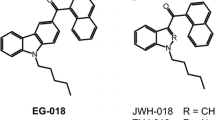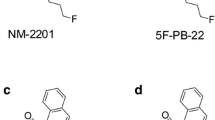Abstract
The drug abuse epidemic within the United States remains one of the nation’s most serious social challenges, especially among adolescents and young adults. Novel psychoactive substances continuously emerge into the illicit drugs-of-abuse market to evade legislation. In 2013, SDB-006 was detected as a novel synthetic cannabinoid (SC) with high binding affinity to CB1 (EC50 = 19 nM) and CB2 (EC50 = 134 nM). Unfortunately, no human metabolism data for SDB-006 are currently available, making it challenging to confirm intake, since all previously investigated SCs were extensively metabolized. The present study aims to recommend appropriate marker metabolites for documenting SDB-006 consumption by investigating its metabolism in human hepatocytes. For metabolite profiling, 10 µM of SDB-006 was incubated in human hepatocytes for 3 h. Metabolite identification in hepatocyte samples was accomplished with high-resolution mass spectrometry via information-dependent data acquisition. Results revealed that SDB-006 was highly metabolized in human hepatocytes. A total of 20 metabolites were characterized, generated mainly from hydroxylation and glucuronidation. Hydroxylation occurred primarily on several positions of the pentyl chain. N-Dealkylation was the other major pathway, including depentylation and debenzylation. Based on our data, we propose 4′-keto-SDB-006 (M19) and pentyl-OH-SDB-006 (M15) as optimal marker metabolites for documenting SDB-006 intake.




Similar content being viewed by others
References
Auwärter V, Dresen S, Weinmann W, Müller M, Putz M, Ferreirós N (2009) ‘Spice’ and other herbal blends: harmless incense or cannabinoid designer drugs? J Mass Spectrom 44:832–837
Namera A, Kawamura M, Nakamoto A, Saito T, Nagao M (2015) Comprehensive review of the detection methods for synthetic cannabinoids and cathinones. Forensic Toxicol 33:175–194
Pertwee RG (2006) Cannabinoid pharmacology: the first 66 years. Br J Pharmacol 147(Suppl 1):S163–S171
Huffman JW, Dai D, Martin BR, Compton DR (1994) Design, synthesis and pharmacology of cannabimimetic indoles. Bioorg Med Chem Lett 4:563–566
Cooper ZD (2016) Adverse effects of synthetic cannabinoids: management of acute toxicity and withdrawal. Curr Psychiatry Rep 18:52
Scheidweiler KB, Jarvis MJ, Huestis MA (2015) Nontargeted SWATH acquisition for identifying 47 synthetic cannabinoid metabolites in human urine by liquid chromatography-high-resolution tandem mass spectrometry. Anal Bioanal Chem 407:883–897
European Monitoring Centre for Drugs and Drug Addiction (2009) Understanding the ‘Spice’ phenomenon. http://www.emcdda.europa.eu/system/files/publications/537/Spice-Thematic-paper-final-version.pdf. Accessed 8 Sep 2016
Hermanns-Clausen M, Kneisel S, Szabo B, Auwärter V (2013) Acute toxicity due to the confirmed consumption of synthetic cannabinoids: clinical and laboratory findings. Addiction 108:534–544
Seely KA, Lapoint J, Moran JH, Fattore L (2012) Spice drugs are more than harmless herbal blends: a review of the pharmacology and toxicology of synthetic cannabinoids. Prog Neuropsychopharmacol Biol Psychiatry 39:234–243
Forrester MB, Kleinschmidt K, Schwarz E, Young A (2012) Synthetic cannabinoid and marijuana exposures reported to poison centers. Hum Exp Toxicol 31:1006–1011
Young AC, Schwarz E, Medina G, Obafemi A, Feng S-Y, Kane C, Kleinschmidt K (2012) Cardiotoxicity associated with the synthetic cannabinoid, K9, with laboratory confirmation. Am J Emerg Med 30:1320.e5–1320.e7
Wohlfarth A, Roman M, Andersson M, Kugelberg FC, Diao X, Carlier J, Eriksson C, Wu X, Konradsson P, Josefsson M, Huestis MA, Kronstrand R (2016) 25C-NBOMe and 25I-NBOMe metabolite studies in human hepatocytes, in vivo mouse and human urine with high-resolution mass spectrometry. Drug Test Anal. doi:10.1002/dta.2044
Diao X, Wohlfarth A, Pang S, Scheidweiler KB, Huestis MA (2016) High-resolution mass spectrometry for characterizing the metabolism of synthetic cannabinoid THJ-018 and its 5-fluoro analog THJ-2201 after incubation in human hepatocytes. Clin Chem 62:157–169
Kemp AM, Clark MS, Dobbs T, Galli R, Sherman J, Cox R (2016) Top 10 facts you need to know about synthetic cannabinoids: not so nice spice. Am J Med 129:240.e1–244.e1
Law R, Schier J, Martin C, Chang A, Wolkin A (2015) Notes from the field: increase in reported adverse health effects related to synthetic cannabinoid use–United States, January–May 2015. Morb Mortal Wkly Rep 64:618–619
Wohlfarth A, Gandhi AS, Pang S, Zhu M, Scheidweiler KB, Huestis MA (2014) Metabolism of synthetic cannabinoids PB-22 and its 5-fluoro analog, 5F-PB-22, by human hepatocyte incubation and high-resolution mass spectrometry. Anal Bioanal Chem 406:1763–1780
Uchiyama N, Asakawa K, Kikura-Hanajiri R, Tsutsumi T, Hakamatsuka T (2015) A new pyrazole-carboxamide type synthetic cannabinoid AB-CHFUPYCA [N-(1-amino-3-methyl-1-oxobutan-2-yl)-1-(cyclohexylmethyl)-3-(4-fluorophenyl)-1H-pyrazole-5-carboxamide] identified in illegal products. Forensic Toxicol 33:367–373
Diao X, Scheidweiler KB, Wohlfarth A, Zhu M, Pang S, Huestis MA (2016) Strategies to distinguish new synthetic cannabinoid FUBIMINA (BIM-2201) intake from its isomer THJ-2201: metabolism of FUBIMINA in human hepatocytes. Forensic Toxicol 34:256–267
Shevyrin V, Melkozerov V, Nevero A, Eltsov O, Baranovsky A, Shafran Y (2014) Synthetic cannabinoids as designer drugs: new representatives of indol-3-carboxylates series and indazole-3-carboxylates as novel group of cannabinoids. Identification and analytical data. Forensic Sci Int 244:263–275
Castaneto MS, Wohlfarth A, Pang S, Zhu M, Scheidweiler KB, Kronstrand R, Huestis MA (2015) Identification of AB-FUBINACA metabolites in human hepatocytes and urine using high-resolution mass spectrometry. Forensic Toxicol 33:295–310
Wohlfarth A, Castaneto MS, Zhu M, Pang S, Scheidweiler KB, Kronstrand R, Huestis MA (2015) Pentylindole/pentylindazole synthetic cannabinoids and their 5-fluoro analogs produce different primary metabolites: metabolite profiling for AB-PINACA and 5F-AB-PINACA. AAPS J 17:660–677
Swortwood MJ, Carlier J, Ellefsen KN, Wohlfarth A, Diao X, Concheiro-Guisan M, Kronstrand R, Huestis MA (2016) In vitro, in vivo and in silico metabolic profiling of α-pyrrolidinopentiothiophenone, a novel thiophene stimulant. Bioanalysis 8:65–82
Chimalakonda KC, Seely KA, Bratton SM, Brents LK, Moran CL, Endres GW, James LP, Hollenberg PF, Prather PL, Radominska-Pandya A, Moran JH (2012) Cytochrome P450-mediated oxidative metabolism of abused synthetic cannabinoids found in K2/Spice: identification of novel cannabinoid receptor ligands. Drug Metab Dispos 40:2174–2184
Sobolevsky T, Prasolov I, Rodchenkov G (2012) Detection of urinary metabolites of AM-2201 and UR-144, two novel synthetic cannabinoids. Drug Test Anal 4:745–753
Tait RJ, Caldicott D, Mountain D, Hill SL, Lenton S (2016) A systematic review of adverse events arising from the use of synthetic cannabinoids and their associated treatment. Clin Toxicol 54:1–13
Andersson M, Diao X, Wohlfarth A, Scheidweiler KB, Huestis MA (2016) Metabolic profiling of new synthetic cannabinoids AMB and 5F-AMB by human hepatocyte and liver microsome incubations and high-resolution mass spectrometry. Rapid Commun Mass Spectrom 30:1067–1078
Diao X, Pang X, Xie C, Guo Z, Zhong D, Chen X (2014) Bioactivation of 3-n-butylphthalide via sulfation of its major metabolite 3-hydroxy-NBP: mediated mainly by sulfotransferase 1A1. Drug Metab Dispos 42:774–781
Wilkinson SM, Banister SD, Kassiou M (2015) Bioisosteric fluorine in the clandestine design of synthetic cannabinoids. Aust J Chem 68:4–8
Carlier J, Diao X, Wohlfarth A, Scheidweiler KB, Huestis MA (2016) In vitro metabolite profiling of ADB-FUBINACA, a new synthetic cannabinoid. Curr Neuropharmacol. doi:10.2174/1570159X15666161108123419
Diao X, Scheidweiler KB, Wohlfarth A, Pang S, Kronstrand R, Huestis MA (2016) In vitro and in vivo human metabolism of synthetic cannabinoids FDU-PB-22 and FUB-PB-22. AAPS J 18:455–464
Diao X, Carlier J, Zhu M, Pang S, Kronstrand R, Scheidweiler KB, Huestis MA (2017) In vitro and in vivo human metabolism of a new synthetic cannabinoid NM-2201 (CBL-2201). Forensic Toxicol 35:20–32
Maurer HH, Meyer MR (2016) High-resolution mass spectrometry in toxicology: current status and future perspectives. Arch Toxicol 90:2161–2172
Zhu Y, Li L, Zhang G, Wan H, Yang C, Diao X, Chen X, Zhang L, Zhong D (2016) Metabolic characterization of pyrotinib in humans by ultra-performance liquid chromatography/quadrupole time-of-flight mass spectrometry. J Chromatogr B 1033-1034:117–127
Kronstrand R, Brinkhagen L, Birath-Karlsson C, Roman M, Josefsson M (2014) LC-QTOF-MS as a superior strategy to immunoassay for the comprehensive analysis of synthetic cannabinoids in urine. Anal Bioanal Chem 406:3599–3609
Jiang J, Pang X, Li L, Dai X, Diao X, Chen X, Zhong D, Wang Y, Chen Y (2016) Effect of N-methyl deuteration on metabolism and pharmacokinetics of enzalutamide. Drug Des Devel Ther 10:2181–2191
Diao X, Deng P, Xie C, Li X, Zhong D, Zhang Y, Chen X (2013) Metabolism and pharmacokinetics of 3-n-butylphthalide (NBP) in humans: the role of cytochrome P450s and alcohol dehydrogenase in biotransformation. Drug Metab Dispos 41:430–444
Diao X, Ma Z, Wang H, Zhong D, Zhang Y, Jin J, Fan Y, Chen X (2013) Simultaneous quantitation of 3-n-butylphthalide (NBP) and its four major metabolites in human plasma by LC–MS/MS using deuterated internal standards. J Pharm Biomed Anal 78-79:19–26
Diao X, Huestis MA (2016) Approaches, challenges and advances in metabolism of new synthetic cannabinoids and identification of optimal urinary marker metabolites. Clin Pharmacol Ther. doi:10.1002/cpt.1534
Acknowledgements
This research was supported by the Intramural Research Program of the National Institute on Drug Abuse, National Institutes of Health. SDB-006 was generously donated by the US Drug Enforcement Administration.
Author information
Authors and Affiliations
Corresponding author
Ethics declarations
Conflict of interest
The authors declare that they have no conflict of interest.
Ethical approval
This article does not contain any studies with human participants or animals performed by any of the authors.
Additional information
X. Diao and J. Carlier contributed equally to this work.
Rights and permissions
About this article
Cite this article
Diao, X., Carlier, J., Scheidweiler, K.B. et al. In vitro metabolism of new synthetic cannabinoid SDB-006 in human hepatocytes by high-resolution mass spectrometry. Forensic Toxicol 35, 252–262 (2017). https://doi.org/10.1007/s11419-016-0350-9
Received:
Accepted:
Published:
Issue Date:
DOI: https://doi.org/10.1007/s11419-016-0350-9




